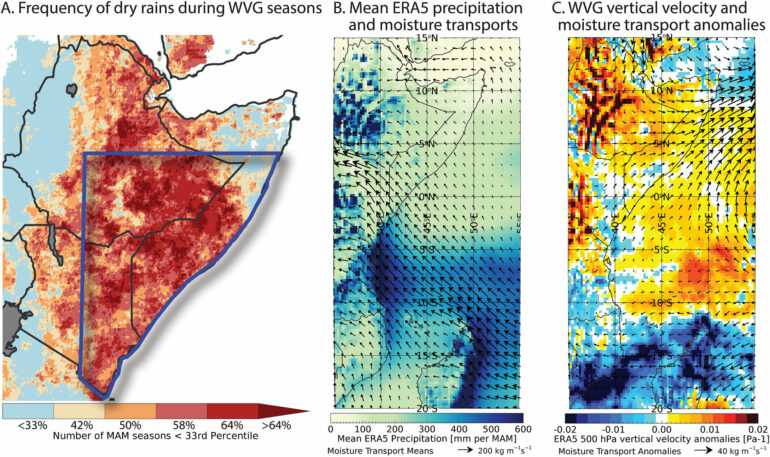Frequent droughts—interspersed with floods—have become the new norm in eastern East Africa over the past few years, driving a massive food security crisis. In 2020, the Horn of Africa entered its longest and most severe dry spell in more than 70 years, and 2022 marked the driest springtime drought on record. More than 20 million people experienced extreme hunger because of failed harvests, and there were more than 9 million livestock deaths.
In what’s been described as the East African climate paradox, climate change models did not anticipate these droughts, projecting instead increased springtime rains. However, researchers with the Famine Early Warning Systems Network (FEWS NET) were able to predict these droughts using tailored forecasts based on sea surface temperatures.
Though identifying the link to Pacific Ocean temperatures has improved predictions, giving humanitarian relief agencies the chance to reduce the loss of lives and livelihoods, scientists previously didn’t fully understand why this connection existed. In a recent study published in Earth’s Future, Chris Funk and colleagues examine what’s causing this link.
La Niña events have become more strongly linked to droughts since the western Pacific Ocean warmed dramatically in 1998. The researchers dug further into data about sea surface temperatures and rainfall observations and noted that rising temperatures in the western Pacific are causing the ocean’s east-to-west sea surface temperature gradient to become more extreme.
In the springtime, when East Africa usually experiences a rainy season, climate change–enhanced La Niñas amplify this phenomenon. These gradients intensify an airflow pattern known as the Walker circulation, which tends to drive high heat and moisture near Indonesia but reduce moisture over East Africa.
The researchers showed that climate models predict the east-to-west Pacific sea surface temperature gradient to continue to strengthen in the coming decades, so it’s likely droughts will continue to be frequent in East Africa. But identifying the link between sea surface temperature and precipitation has already allowed FEWS NET scientists to predict many of the worst dry spells, as well as to anticipate extreme rains and flooding in 2023. This study further improves scientists’ understanding of how climate change is bringing more extreme, but predictable, fluctuations in the Walker circulation.
More information:
Chris Funk et al, Frequent but Predictable Droughts in East Africa Driven by a Walker Circulation Intensification, Earth’s Future (2023). DOI: 10.1029/2022EF003454
Provided by
American Geophysical Union
This story is republished courtesy of Eos, hosted by the American Geophysical Union. Read the original story here.
Citation:
Ocean warming sets the stage for dangerous but predictable East Africa droughts (2023, December 7)



